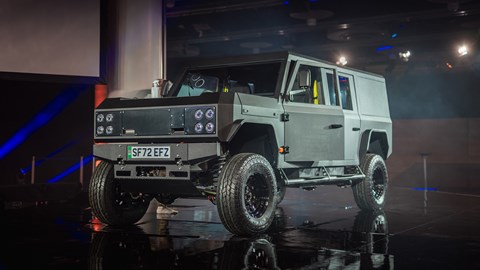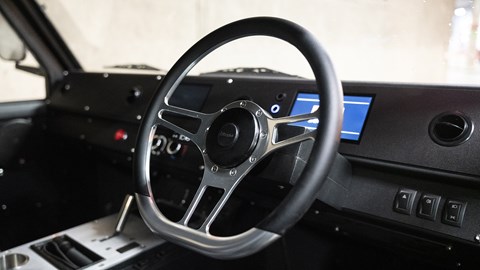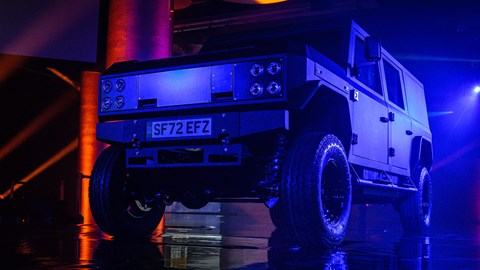► New British-built electric 4×4 and pick-up
► Focus on utility – massive one-tonne payload
► Up to 375bhp and 186-mile range
Scottish start-up Munro has unveiled its new electric pick-up truck at the 2023 Fully Charged Live show. It’s a more utilitarian, flat-bed bodystyle than the truck that sired it, designed to appeal to working folk who need to transport cargo but in a silent, electric manner.
It’s one of the toughest EVs we’ve yet seen and the Munro Mk_1 Pick-Up is listed with a 1050kg payload and 3.5-tonne braked towing capacity, giving it pretty serious commercial creds.
Munro claims the pick-up is ‘engineered to enable customers operating in ultra-challenging environment sectors such as mining, construction, utilities, agriculture, and defence to meet decarbonisation targets.’

The pick-up costs from £49,995 (excluding VAT) and first deliveries start later this year. Read on for the full background on Munro and the hard-top truck 4×4.
Munro Mk_1 Truck and pick-up: the background
If there’s one place in the UK that gets the drive for ‘independence’, it’s Scotland; self-sufficiency and the right to go, well, almost anywhere is baked in. It shouldn’t be a surprise that one of the first fully electric proper 4x4s to go on sale in the UK is the brainchild of a Scottish start-up. Munro is named for the breathtaking mountains that dominate the landscape north of the Forth, and the Munro Mark 1 (styled MK_1) is built to climb them.
It’s a no-nonsense, pure-electric off-roader that aims to fill the void left by the Land Rover Defender’s move upmarket. In theory it could also act as a direct rival for the upcoming pure-electric Mercedes G-Wagen and the eventual Ineos Grenadier EV, though it is aimed at the more utilitarian end of that market for now.
The Munro Mark 1’s powertrain looks unusual alongside typical electric cars, but reflects the current best practice for off-road utility, rather than all-wheel-drive performance. Instead of an electric motor on each axle (like you’d find on a Tesla Model Y), it has a single motor under the bonnet sending power to the wheels through a two-speed transmission and a pair of live axles – just like a traditional petrol-powered off-roader.
There’s a tendency in electrified designs towards trading transfer boxes for trunking. It’s telling that both Land Rover and Jeep have retained a mechanical 4×4 setup in their off-road focused electrified models, when the rest of the range adopts separate e-motors and axles.

Built around a relatively novel axial flux motor (the same technology used in the Ariel Hipercar to package one motor per wheel), the Munro Mark 1 is offered with a choice of 294bhp 220kW, or 375bhp 280kW powertrains, and the standard 61kWh battery pack can be upgraded to 82kWh. The lower specification is important, as it allows the MK_1 to come in at a whisker under £50,000 (when 74kWh of battery alone can add £30,000 to some commercial EVs).
The highest specification models can reach 60mph in less than five seconds, but the Munro Mark 1 is designed and geared to be all torque. The 280kW motor can generate 516lb/ft, distributed to all four wheels via a locking centre differential. Front and rear diff locks are an option, supplementing the familiar behaviour of old-school live axles front and rear – just like the original Defender.
The 82kWh battery pack has a maximum range of 186 miles, though Munro also quotes an off-road running time of 16 hours, reflecting the agriculture, mining, utility and off-road enthusiast market where it expects to receive the first orders.
Will it be any good as a workhorse?
If you hadn’t already guessed from the set-square styling, the Munro Mark 1 is all about utility. It has permanent four-wheel drive, a tough ladder chassis, a one-tonne payload and enough space in the back to carry a euro pallet. It can also tow up to 3500kg, which is more than enough to haul everything from horses to heavy machinery. Aluminium tie down rails can accept 400kg per attachment, and the passenger area is designed to be similarly functional with room to use laptops and other equipment if the 4×4 is the only shelter available.
Leveraging the space available thanks to the electric powertrain, the Munro’s front includes over-wheel ‘saddlebags’ for easy storage of gloves, tools and other bits you wouldn’t want in the cabin. If you think that sort of clever use of space sounds familiar, you may have guessed where Munro’s designer joined the team from.
Munro’s specifications suggest the 220kW model has plenty of torque – 442lb/ft – but the 280kW Performance version should keep fans of big diesels and V8s happy. The motor produces 375bhp and 516lb/ft of torque – and the company says the car’s four-wheel drive system allows it to get its power down smoothly in all conditions, achieving 62mph in 4.9 seconds on road.

Munro says the Mark 1 is very handy off-road. It has 48cm of ground clearance and can wade through 80cm-deep water. It also has approach and departure angles of 84 and 51 degrees respectively, which means it should be able to crest hills (the breakover angle is 148 degrees), and rocks that would strand most off-roaders. For comparison, the Land Rover Defender 90 has approach and departure angles of 37.5 and 40 degrees respectively – and that’s only when its air suspension is in its highest position.
Sounds tough. Bet it’ll be jolly expensive if you break it, though
Not necessarily. Munro knows the Mark 1 will have a hard life – and the tougher you are on your tools, the more often they’ll break. For that reason, Munro built the development Mark 1 from readily available parts. The suspension and braking components are are all off-the-shelf bits, though Munro claims to be producing its own chassis, bodies and axles for production models.
The finished MK_1 looks remarkably similar to the first MV1 engineering prototypes (above) that started out as Ibex kits, though Ibex has not been involved in the development. The MK_1 has been developed in-house, with styling the work of Ross Compton; a name familiar to Bollinger and Atlis followers. The chassis is 5mm galvanised steel, the body, laser-cut and hand-formed aluminium with roll-over protection and optional falling-object protection – essentially extra reinforcement for high-risk environments.

The idea was to make the Munro electric 4×4 easy and cheap to maintain. Ross Anderson, the company’s co-founder, said: ‘We decided early on that we weren’t looking to re-invent the wheel. We’ve used straightforward and readily available components to minimise the cost of production and provide owners with an accessible means to maintain and repair their own vehicle. We hope that our vehicles will last longer, making them better for the environment than most other ‘consumable’ vehicles on the market.’
More importantly, Munro says it was able to completely disassemble and reassemble the car on its workshop floor, which stands it in good stead for farmyard fixers and home mechanics alike.
What about the interior?
It’s about as utilitarian as the exterior. Munro’s engineers have trialled recycled wool carpets and a thermally insulated headliner, but the final specification depends on the buyer’s needs. There’s a double-din touchscreen head unit in the centre of the dashboard and a digital gauge cluster ahead of the driver, in addition to simpler comfort items like cupholders and leather seats.
For workplaces where the radio is banned, it can be replaced with communications equipment such as CB transceivers. There’s enough space inside for five passengers, with the assumption that the Munro may need to double as an office; it’s possible to slide the front seat fully back and still leave legroom for occupants in the seat behind.

Naturally, the interior is geared more towards function than form. The dashboard and door panels have a practical wipe-down paint finish, the rear of the vehicle is ply-lined like a work van and all the switches are proper physical buttons that are chunky enough to operate while wearing gloves.
How much is the Munro MK_1?
The Munro’s headline figure is competitive at £49,995 ex. VAT for the 130 wheelbase five-seater 4×4 Utility. This is a 220kW, 61kWh version – which has a range of 141 miles or 12 hours, and loses nothing in terms of towing or hauling ability.
Choose the larger battery and you’ll pay £10,000 more, with the Range model coming in at £59,995 ex. VAT. For V8-baiting pace, the Performance model adds another £10,000, making the most expensive, 186-mile range Munro £69,995 ex. VAT. For businesses, the high payload and electric powertrain may influence how relevant VAT is, though it’s unusual to quote prices without VAT for a five-seater model.
Backing up the relatively competitive pricing is a competitive warranty – at five years and 100,000 miles, the package promises to recognise the need to maintain vehicles in the field. It’s supported by an industry-standard eight year, 100,000 mile battery warranty.

Reflecting newer battery technology, this has an 80 percent capacity guarantee, though as the pack uses compact, modular cells this should be an easy EV to maintain for the long term. The rate at which you can drain the battery is limited in part by an 80mph top speed; this may explain why the 220kW and 280kW models have the same maximum range.
Recharging is less restrictive; it supports 100kW fast charging, and can charge from 15 to 80 percent capacity in 36 minutes when connected to an appropriate DC rapid charger. It’ll achieve the same state of charge in three hours when hooked up to a 22kW AC wallbox charger. On-board single-phase charging supports 7kWh, and accessories can be supplied via a selection of DC and AC options for winches, lights and power. Standard equipment includes two AC inverters to power a kettle and a microwave, two wireless charging pads, and two USB-C ports.
When will the Munro MK_1 go on sale?
Munro has already started to take pre-orders for the car. It’s available in two specifications, called Utility and Commercial, both of which can be reserved with a £500 deposit. Customisation options reflect the hand-made, low volume nature of the initial production run, with a new factory allowing expansion from an initial 250, to 2,500 vehicles per year from 2024 onwards. Given the lead times and financial backing behind even Ineos and the Grenadier, to achieve a production-standard in-house body and chassis in such a short time is remarkable; this is definitely one to watch.
